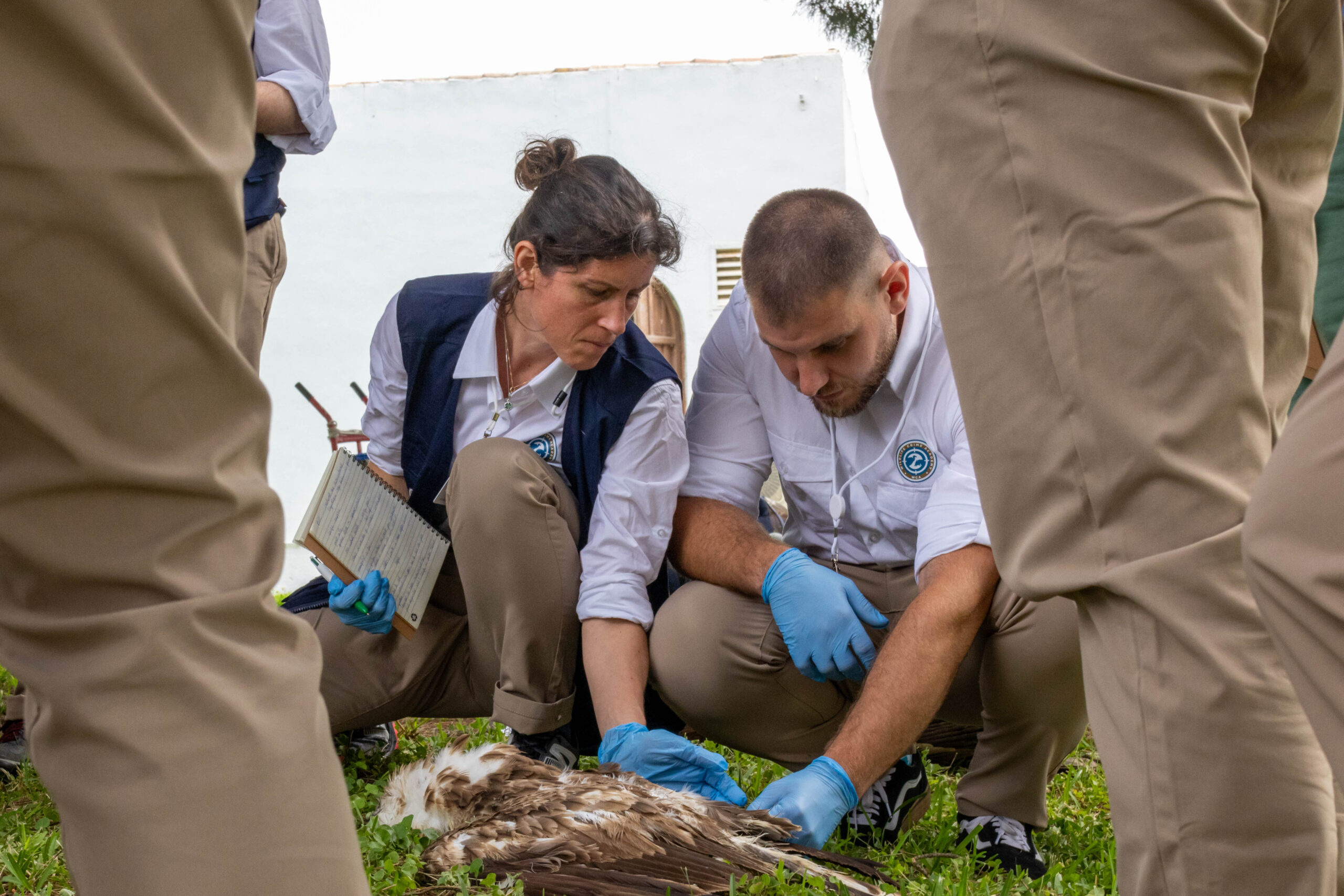
Cinereous Vulture Carrascalinho has been flying in the face of danger for the past few weeks – literally. We tracked the movements of the young bird through its transmitter and noticed he has been flying near wind turbines in Northwest Spain. Vultures often collide with turbines, which can cause severe injury or death. Thanks to the GPS technology, and the help of our colleagues, the regional authorities and the wind turbine company, we were able to act fast and prevent any accidents!
Moving dangerously close to wind turbines
Carrascalinho has been giving us quite a scare over the past few weeks after he returned to an open area full of wind turbines in Galicia (Spain). Although most of the time the bird flew 200 m above ground level at the site, some turbines were hazardous, several of which he passed within 100m of when leaving his favoured ground site, at a height above ground level of only 110m – within collision risk height. Landing and taking off near the turbines were, of course, very dangerous. When we realised this, we quickly contacted colleagues in Spain to ask for their help, and they took immediate action! Together, we managed to track the bird’s movements, check what was attracting him in the area and shut down the turbines temporarily!
Shutting down the wind turbines
Our colleagues from Sociedade Portuguesa para o Estudo das Aves (SPEA) contacted a colleague from Sociedad Española de Ornitología (SEO), who then contacted the authorities in Galicia. Once alerted, the Department of the Environment of the Xunta de Galicia and the Ministry of Industry quickly requested the wind farm to shut down the turbines. Thankfully, the company turned off the turbines temporarily to prevent collisions with the vulture. In order to reduce the risk of collision, we will continue to closely monitor the tracking data and the situation in the field, together with our partners, so that the turbines can be stopped when necessary. This is a complex and dynamic situation, but with continued collaboration and the positive cooperation of the wind farm operator, we will continue to work to reduce the risks for Carrascalinho and other vultures in the area.
What attracted the vulture to the area?
The Xunta de Galicia sent agents to investigate why the bird frequented the area. On the first day they discovered why – he was scavenging upon a horse carcass. In these mountains the presence of vultures in summer is common since horses and cows freely graze the land and often die during this period. Another reason why there is an abundance of carrion in the area is due to wolves preying on animals. Recently, a group of 40 Griffon Vultures was observed feeding on a dead horse that was killed by wolves. To encourage the bird to leave the area, the Xunta de Galicia covered the carcass of the dead horse with a large plastic sheet, which is a mandatory protocol when there is a carcass near wind turbines to try to avoid collisions.
Carrascalinho’s story
The juvenile Cinereous Vulture was recovered in the Porto area and re-released in the LIFE Rupis project area in January 2019. Ahead of its release, the bird was equipped by Associação Transumância e Natureza (ATN) with a GPS transmitter, provided by the VCF and funded by the MAVA Foundation, to monitor its movements. Since then the bird has moved extensively in northern Spain, even travelling as far as Bilbao! In recent months the bird was attracted to the Serro do Cando in Galicia Autonomous Region, apparently due to an abundance of carrion, and this is when we noticed that it was moving hazardously close to the wind turbines.
Follow his movements
Threats to vultures caused by energy infrastructure
The Vulture Multi-species Action Plan (Vulture MsAP), co-developed by us here at the Vulture Conservation Foundation, and endorsed by the Convention for Migratory Species (CMS), identified the often overlooked threat to vultures posed by energy infrastructure particularly electrocution and collisions. Collision with energy infrastructure occurs when vultures are unable to distinguish the power line or wind turbine against the background of the natural vegetation as they fly near them.
Mitigating the threat of collisions
Compared to preventing collisions, mitigating electrocutions is relatively straightforward, as the insulation of cables in high-risk poles is relatively easy and inexpensive. In the long term, selecting less dangerous pole designs, or even burying lines in high-biodiversity areas seem better options. There are many projects, including our own LIFE-funded projects such as LIFE Rupis, Vultures Back to LIFE, LIFE GYPHELP and LIFE Re-Vultures, that are working to tackle the threat of electrocution with electricity infrastructure. The MAVA Foundation is also funding projects across the eastern Mediterranean flyway to minimise the danger of electrocution and collision.
However, mitigating collisions is more complex because vultures’ large sizes, visual fields and flying styles make them particularly vulnerable, especially in favoured foraging or roosting areas. In addition, it is often difficult to communicate with authorities and wind power companies to alert them of imminent collision risks and request shutdowns of dangerous turbines.
Therefore, this is a great example of international collaboration and fast and effective action by the regional authorities and the wind farm operator to quickly shutdown the wind turbines, and we are so glad we managed to save the vulture from a possible collision! It was all thanks to international cooperation that is fostered by our common goal to conserve nature. We will continue to monitor the movements of Carrascalinho closely and communicate with the authorities and partners who will be monitoring the situation on the ground.
The VCF would like to thank the Xunta de Galicia, the company operating the windfarm, the agentes de medio ambiente de Galicia, as well as the local group from SEO/BirdLife, and all our Portuguese colleagues, for their help, responsiveness and support. It is just one Cinereous Vulture saved, but it shows that when there is will, there is a way – All together for Vultures!
















